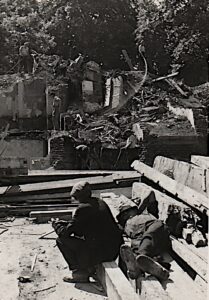The fact that a village church survived two 20th century disasters is testament to a gritty community. Hit by a flying bomb in 1944 and struck by lightning in 1964, St James, Abinger Common is indestructible, declares Greta Morley (from The Dorking & Leatherhead Advertiser, 1st July 2004)
Sixty years ago the reality of the destruction of war was brought home to the sleepy backwater of Abinger Common. Shortly before 8am on [Thursday] August 3, as the rector was on his way to celebrate communion, the parish church of St James took a direct hit from a German flying bomb. The damage was massive but mercifully no one was injured. Five minutes later and it would have been a different story, as the church would have begun to fill with parishioners.
After being hit by a flying bomb in 1944, St James’ Church, Abinger, was virtually destroyed but no-one was hurt. A few minutes later and the story would have been very different. The calamity brought home to the tiny village the realisation that nowhere in southern England was safe from the awesome destructive force caused by the feared doodlebug. London and the south-east’s ports may have been preferred targets but there was no telling where the pilotless weapon would end up once its puttering engine cut out.
The fighting in Europe was nearing its final phase but the war was not yet over and Abinger now had the scars to prove it. What’s more, with building restrictions in force at the time and immediately after the war it was to be some years before repairs could begin.
The verger of St James on the day the bomb fell was an 18-year-old railway employee and volunteer with the National Fire Service. Michael Bowler. He had taken on the job three years previously. In his account of what happened that day, he says: “There was a tremendous explosion with dust everywhere but no fire. Many of the cottages nearby had their windows blown out. The pub opposite had tiles knocked off the roof and the manor house at the rear of the church was also affected. It was amazing that no one was hurt. The communion service was due to start at 8am and if the bomb had fallen a few minutes later than it did who knows what might have happened.”

The incident was recorded in the Dorking and Leatherhead Advertiser of August 18, but few people other than those living in the immediate vicinity would have had much of a clue what had actually happened. Wartime reporting restrictions were in force and only an oblique reference was permitted. A three-paragraph story entitled Flying bombs: One Fatal Casualty began: “An ancient inn, a parish church and a school were among the buildings damaged by one of three flying bombs which fell in a district of Southern England last week”.
At poor St James, the word “damage” hardly conveyed the terrible destruction the bomb had caused. The complete story was only released by the censor on September 7 and a report was then circulated to every house in the parish. The 850-year-old building was to all intents and purposes destroyed.
The bomb was thought to have exploded in the air after hitting the belfry or its spire. It might even have struck a tall cyprus tree growing close to the south-west corner of the nave. After the explosion, the lower part of the tree still stood but the upper half had been torn off and was found inside the ruined nave near the chancel. The remains of the bomb fell in the paddock outside the west wall of the churchyard.
The fighting in Europe was nearing its final phase but the war was not yet over and Abinger now had the scars to prove it. What’s more, with building restrictions in force at the time and immediately after the war it was to be some years before repairs could begin.
The west wall of the nave, including the belfry and spire and the great tie beam on which they were supported, plus all the roof of the nave, were completely demolished. So too was the south door and porch, a great part of the north wall including three Norman windows and the south wall up to a point beyond the porch. The blast stripped all the roofs of the building, and the lych-gate, of their traditional Horsham stone slabs except for parts of the north face of the north aisle. Fragments of glass from all the windows lay outside.
The rector, the Rev LF Meade, was soon joined at the scene by the Archdeacon of Dorking Canon Newill, the Bishop of Guildford, Dorking MP Gordon Touche and architects from the diocese and the Ministry of Works. The general opinion was that the whole building was so badly damaged that it must be reported to the War Damage Commission as a total loss despite some parts still standing. Some articles had escaped damage. A curious survival was two bottles of communion wine which had been stored inside the corner cupboard in the vestry. The cupboard itself lay on the floor while the bottles had been blown through the vestry door and the north aisle before landing near the altar. They were unbroken.
After the initial shock of the explosion, the parish got together to rescue what could be saved. Crosses, candlesticks and vases were taken to the rectory. The clear-up began and was assisted by 40 former Italian prisoners of war who were camped in the neighbourhood. Apart from the damage to the building, the churchyard also took a pounding. Tall lime trees were stripped bare, the churchyard wall had come down and many monuments and gravestones were broken.
The cost involved and post war shortages delayed rebuilding and reconcentration until May 1951, the year of the Festival of Britain, when the Bishop of Guildford performed the ceremony before a large congregation.
The Dorking and Leatherhead Advertiser once recorded the event. It reported the bishop, the Rt Rev HC Montgomery Campbell, as saying church people should never be satisfied with what they had already achieved and always try to reach higher standards of worship and life.
In the aftermath of storm havoc at Abinger in 1964, the rector, the Rev Paul Kelly, surveys his damaged church. Lightning struck deep into the base of the spire of St James. During a storm raging over southern England in June 1964, a bolt of lightning struck the tower and set it on fire. Firemen were called and villagers, many presumably with an acute feeling of deja vu, rallied round to rescue what could be saved.
Again the great and the good arrived, including the Bishop George Reindorp, the Archdeacon of Dorking Kenneth Evans, the Rural Dean Donald Gray and the Duchess of Marlborough, hot foot from Deepdene House, Dorking. The Advertiser of the day had five photos of the destruction on its front page and a subheading which read: “Second disaster in 20 years for fated Abinger building.”
A new disaster, a new appeal and, for a second time, St James donned its Phoenix mantle. The fact that it is still there, bombed, lightning blasted, scarred but above all indestructible, is testament to the gritty little community which has managed to cope with the the very worst man and nature has thrown at it.
Plans for rebuilding started in 1945.
See also the preface to the Third edition of Abinger Parish Church – J A Gibbs 1946 and a pamphlet by JA Gibbs 1944.
Abinger Common, Surrey RH5 6HZ ///delay.trials.plans
Tel: 01306 737160


Data Protection & Privacy
We do not track any browsing activity on this website.
We may sometimes link to external sites and social media but are not responsible for the content of these websites and you should refer to their individual privacy and cookies policies.
If you are included in an event photo and do not wish to be please contact us and we will remove – Contact Us

If you would like to apply for a Login account to help update this site, please email the web team here.